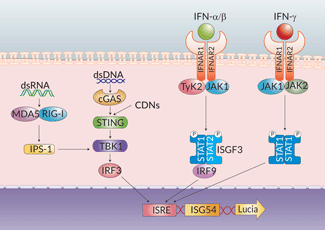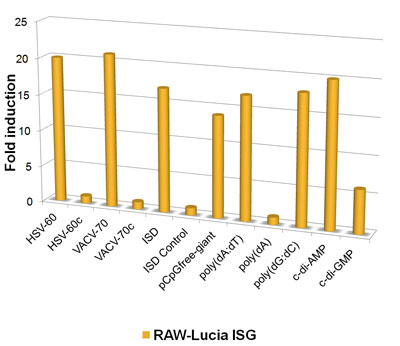RAW-Lucia™ ISG Cells
| Product | Unit size | Cat. code | Docs. | Qty. | Price | |
|---|---|---|---|---|---|---|
|
RAW-Lucia™ ISG Cells Mouse Macrophages - CDS Reporter Cells |
Show product |
3-7 x 10e6 cells |
rawl-isg
|
|
||
|
RAW-Lucia™ ISG vial Additional cell vial |
Show product |
3-7 x 10e6 cells |
rawl-isg-av
|
Notification: Reference #rawl-isg-av can only be ordered together with reference #rawl-isg.
IRF-Lucia reporter mouse macrophages

RAW-Lucia™ ISG cells signaling
RAW-Lucia™ ISG cells were generated from the murine RAW 264.7 macrophage cell line by stable integration of an interferon regulatory factor (IRF)-inducible Lucia luciferase reporter construct.
RAW 264.7 have been reported to express many pattern recognition receptors (PRRs), including the cytosolic DNA sensors (CDS), IFI16 [1], DDX41, AIM2 [2], and cGAS [3], the dsRNA sensor RIG-I [4], and the cyclic dinucleotide sensor STING [5]. Activation of most of these receptors induces the production of type I IFNs through the TBK1-IRF3 axis.
Cell line description:
RAW-Lucia™ ISG cells express the Lucia luciferase gene under the control of an ISG54 minimal promoter in conjunction with five IFN-stimulated response elements. Thus, RAW-Lucia™ ISG cells allow the monitoring of IRF activation by determining the activity of Lucia luciferase. The levels of IRF-induced Lucia luciferase in the cell culture supernatant can be easily monitored using QUANTI-Luc™ 4 Lucia/Gaussia, a Lucia and Gaussia luciferase detection reagent. RAW-Lucia™ ISG cells are resistant to Zeocin®.
RAW-Lucia™ ISG cells are responsive to murine IFN-α and IFN-β but do not respond to their human counterparts. They are also responsive to PRR ligands that trigger the IFN signaling pathway, including CDS ligands, such as transfected double-stranded DNA, RIG-I ligands, such as transfected double-stranded RNA, and STING ligands, such as cGAMP.
Features of RAW-Lucia™ ISG cells:
- Fully functional STING/TBK1/IRF3 signaling pathway
- Readily assessable Lucia luciferase reporter activity
- Functionally tested and guaranteed mycoplasma-free
Applications of RAW-Lucia™ ISG cells:
- Studying the STING/TBK1/IRF3 signaling pathway
- Studying the RIG-I/TBK1/IRF3 signaling pathway
Note: RAW-Blue™ ISG cells, which express the SEAP reporter gene, have been discontinued. Instead, you can use our RAW-Lucia™ ISG cells, which express the Lucia luciferase reporter gene.
References:
1. Kawasaki T. et al., 2011. Recognition of nucleic acids by pattern-recognition receptors and its relevance in autoimmunity. Immunol Rev. 243(1):61-73.
2. Stein SC & Falck-Pedersen E., 2012. Sensing adenovirus infection: activation of interferon regulatory factor 3 in RAW 264.7 cells. J Virol. 86(8):4527-37.
3. Lam E. et al., 2014. Adenovirus Detection by the cGAS/STING/TBK1 DNA Sensing Cascade. J Virol. 88(2):974-81.
4. Melchjorsen J. et al., 2005. Activation of innate defense against a paramyxovirus is mediated by RIG-I and TLR7 and TLR8 in a cell-type-specific manner. J Virol. 79(20):12944-51.
5. Tanaka Y. & Chen ZJ., 2012. STING specifies IRF3 phosphorylation by TBK1 in the cytosolic DNA signaling pathway. Sci Signal. 5(214):ra20.
Specifications
Antibiotic resistance: Zeocin®
Growth medium: DMEM medium, 2 mM L-glutamine, 10% FBS supplemented with 100 µg/ml Normocin™ and 200 µg/ml Zeocin®.
Guaranteed mycoplasma-free
Back to the topContents
- 1 vial containing 5-7 x 106 cells
- 100 μl Zeocin® (100 mg/ml)
- 1 ml Normocin™ (50 mg/ml)
- 1 tube of QUANTI-Luc™ 4 Reagent, a Lucia luciferase detection reagent (sufficient to prepare 25 ml)
![]() Shipped on dry ice (Europe, USA, Canada and some areas in Asia)
Shipped on dry ice (Europe, USA, Canada and some areas in Asia)
Details
STING (stimulator of interferon genes; also known as TMEM173, MITA, MPYS and ERIS) is essential for the interferon (IFN) response to cytosolic nucleic acids, such as microbial or self-DNA [1, 2], and acts as a direct sensor of cyclic dinucleotides (CDNs) [3]. CDNs are important second messenger molecules in bacteria, affecting numerous responses of the prokaryotic cell. In mammalian cells, CDNs act as agonists of the innate immune response [4]. CDNs bind directly to and activate STING leading to TANK Binding Kinase 1 (TBK1)-dependent interferon regulatory factor 3 (IRF3) activation and type I IFN production. IFNs then activate the JAK-STAT pathway with subsequent activation of IFN-stimulated response elements (ISRE) in the promoters of IFN-stimulated genes (ISG).
1. Wan D. et al., 2020. Research Advances in How the cGAS-STING Pathway Controls the Cellular Inflammatory Response. Front Immunol. 11:615.
2. Ishikawa H. & Barber, G., 2008. STING is an endoplasmic reticulum adaptor that facilitates innate immune signalling. Nature 455, 674–678.
3. Burdette D.L. et al., 2011. STING is a direct innate immune sensor of cyclic di-GMP. Nature 478(7370):515-8.
4. Wu J. et al., 2013. Cyclic GMP-AMP is an endogenous second messenger in innate immune signaling by cytosolic DNA. Science 339(6121):826-30.






